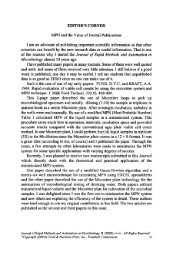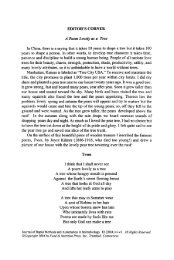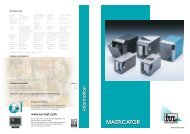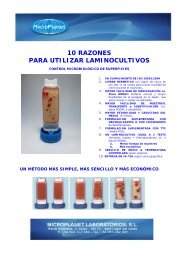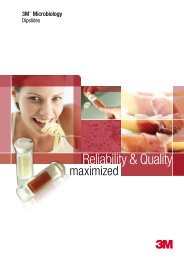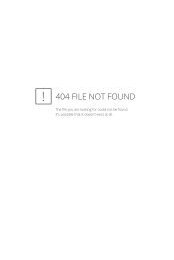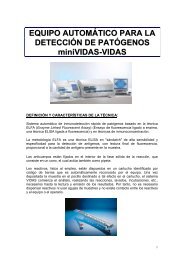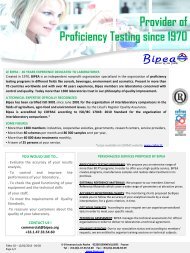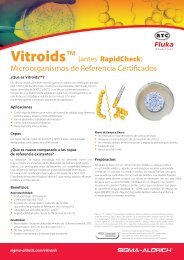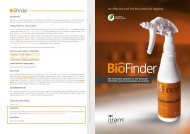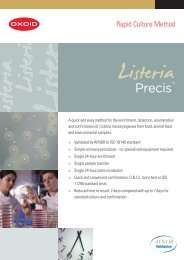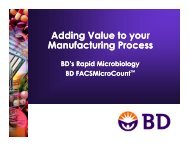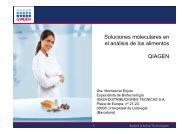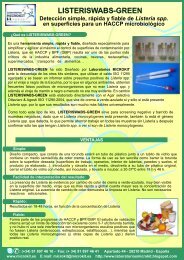You also want an ePaper? Increase the reach of your titles
YUMPU automatically turns print PDFs into web optimized ePapers that Google loves.
3M Food Safety<br />
3M <strong>Petrifilm</strong> <strong>Aqua</strong> Enterobacteriaceae Count Plate<br />
3M <strong>Petrifilm</strong> <strong>Aqua</strong> Yeast and Mold Count Plate<br />
Technician<br />
Productivity<br />
Maximized<br />
Interpretation Guide<br />
Introducing 3M <strong>Petrifilm</strong> <strong>Aqua</strong> Plates for Water Testing, offering<br />
four plates to cover your unique testing needs — Heterotrophic Count,<br />
Coliform Count, Enterobacteriaceae Count and Yeast & Mold Count.<br />
3M <strong>Petrifilm</strong> <strong>Aqua</strong> Plates are ideal for testing bottled water.
2<br />
Interpretation Guide:<br />
3M <strong>Petrifilm</strong> <strong>Aqua</strong> Plates for Water Testing<br />
The 3M <strong>Petrifilm</strong> <strong>Aqua</strong> Plate system brings the convenience of 3M <strong>Petrifilm</strong> Plate technology to water testing 1 . The 3M<br />
<strong>Petrifilm</strong> <strong>Aqua</strong> Plate’s compact, easy-to-use format brings space savings and reduced waste to the laboratory. An independent,<br />
third party study 2 indicates 3M <strong>Petrifilm</strong> <strong>Aqua</strong> Plates do not perform statistically different from either SMEWW 3 methods or<br />
commonly used bottled water testing methods 4 .<br />
This guide familiarizes you with results on the 3M <strong>Petrifilm</strong> <strong>Aqua</strong> Enterobacteriaceae Count Plate and 3M <strong>Petrifilm</strong> <strong>Aqua</strong><br />
Yeast & Mold Count Plate. For more information, contact the official 3M Food Safety representative nearest you.<br />
3M <strong>Petrifilm</strong> <strong>Aqua</strong> Enterobacteriaceae<br />
Count Plate (AQEB)<br />
The 3M <strong>Petrifilm</strong> <strong>Aqua</strong> AQEB Plate is a sample-ready culture<br />
medium system which contains Violet Red Bile (VRB) nutrients,<br />
a cold-water-soluble gelling agent, and a tetrazolium indicator that<br />
facilitates colony enumeration. 3M <strong>Petrifilm</strong> <strong>Aqua</strong> AQEB Plates are<br />
used for the enumeration of Enterobacteriaceae in the bottled water<br />
industry. On the 3M <strong>Petrifilm</strong> <strong>Aqua</strong> AQEB Plate, Enterobacteriaceae<br />
will appear as red colonies with yellow zones, red colonies with gas<br />
bubbles, or red colonies with yellow zones and gas bubbles.<br />
See Page 3<br />
3M <strong>Petrifilm</strong> <strong>Aqua</strong> Yeast and Mold<br />
Count Plate (AQYM)<br />
The 3M <strong>Petrifilm</strong> <strong>Aqua</strong> AQYM Plate is a sample-ready culture<br />
medium system which contains nutrients supplemented with<br />
antibiotics, a cold-water-soluble gelling agent, and an indicator that<br />
facilitates yeast and mold enumeration. 3M <strong>Petrifilm</strong> <strong>Aqua</strong> AQYM<br />
Plates are used for the enumeration of yeast and mold in bottled<br />
water industry. See Product Instructions for more information on<br />
differentiating yeast and mold colonies.<br />
See Pages 4–5<br />
1 3M has not documented the performance of 3M <strong>Petrifilm</strong> <strong>Aqua</strong> Plates for water samples other than bottled water. The use and validation of 3M <strong>Petrifilm</strong> <strong>Aqua</strong> Plates to<br />
test other types of water samples, such as process or rinse water, is at the sole discretion and responsibility of the end user.<br />
2 Q Laboratories, Inc, Cincinnati, OH, USA study comparing 3M <strong>Petrifilm</strong> <strong>Aqua</strong> Plate performance vs. reference methods. Study presented at 2011 International Association for<br />
Food Protection (IAFP).<br />
3 Standard Methods for the Examination of Waste Water (SMEWW) 9215A6a and 9222E2b<br />
4 SO 6222, ISO 9308-1
3M <strong>Petrifilm</strong> <strong>Aqua</strong> Enterobacteriaceae Count Plate (AQEB)<br />
Negative Plate and Plates with Colonies<br />
Figure 1<br />
AQEB plate<br />
Count: 0<br />
Observation: Gas bubbles surrounding filter do not indicate<br />
microbial growth. See circle for example.<br />
Figure 3<br />
AQEB plate with high count<br />
Count: 17 cfu<br />
Observation: Red colonies without acid or gas production (circle)<br />
are not counted as Enterobacteriaceae.<br />
Figure 2<br />
AQEB plate with low count<br />
Count: 2 cfu<br />
Observation: Enterobacteriaceae are identified by the presence of<br />
acid (yellow halo) and/or colony-associated gas bubbles.<br />
Figure 4<br />
AQEB plate with high count<br />
Count: 43 cfu<br />
Observation: Colony color can vary from pink to faint tan. Yellow<br />
halo and large gas bubbles can be associated with very faint<br />
colonies. Red colony not associated with either acid production or<br />
gas are not counted as Enterobactereaceae (see circle).<br />
3
4<br />
Interpretation Guide:<br />
3M <strong>Petrifilm</strong> <strong>Aqua</strong> Plates for Water Testing<br />
3M <strong>Petrifilm</strong> <strong>Aqua</strong> Yeast and Mold Count Plate (AQYM)<br />
Negative Plate and Plates with Colonies<br />
Figure 1<br />
AQYM plate<br />
Count: 0<br />
Figure 3<br />
AQYM plate with low count<br />
Count: 10 cfu<br />
Observation: Note two small, faint colonies.<br />
Figure 2<br />
AQYM plate with low count<br />
Count: 10 cfu<br />
Observation: Mold colonies are large with a dark center<br />
and diffuse edge.
Plates with High Counts<br />
Figure 4<br />
AQYM plate with high count<br />
Count: 31 cfu<br />
Observation: Yeast colonies.<br />
Figure 5<br />
AQYM plate with high count<br />
Count: 51 cfu<br />
Observation: Estimate colony count when molds merge; darker<br />
centers can help enumerate colonies. Count colonies partially or<br />
totally off of the filter.<br />
5
6<br />
Reminders for Use<br />
Storage for Plates Hydration Procedure<br />
A<br />
D<br />
G<br />
K<br />
≤8°C<br />
Store unopened packages at ≤8°C (≤46°F).<br />
Use before expiration date on package. In<br />
areas of high humidity where condensate<br />
may be an issue, it is best to allow packages<br />
to reach room temperature before opening.<br />
Carefully roll top film down to<br />
avoid entrapping air bubbles.<br />
Do not let top film drop.<br />
Following standard procedures<br />
for water analysis, membrane<br />
filter water sample using a<br />
47mm, 0.45 micron pore size<br />
Mixed Cellulose Ester (MCE) filter.<br />
Incubation<br />
3M <strong>Petrifilm</strong> <strong>Aqua</strong> Enterobacteriaceae Count Plate (AQEB)<br />
E<br />
Incubate 3M <strong>Petrifilm</strong> <strong>Aqua</strong> AQEB Plates<br />
in a horizontal position, clear side up, in<br />
stacks on no more than 20 plates at<br />
34–37° for 24 ± 2 hours.<br />
B<br />
With flat side down, place<br />
spreader on top film over<br />
hydration diluent.<br />
Lift top film.<br />
H I<br />
To seal opened package, fold end over<br />
and tape shut. Do not refrigerate opened<br />
packages. Use 3M <strong>Petrifilm</strong> <strong>Aqua</strong> AQEB<br />
Plates within one month after opening.<br />
Interpretation<br />
F<br />
L 3M <strong>Petrifilm</strong> <strong>Aqua</strong> AQEB Plates can be<br />
counted on a standard colony counter or other<br />
illuminated magnifier. Refer to the Interpretation<br />
Guide section when reading results.<br />
C<br />
Place filter in the center of<br />
the well. Roll top film down to<br />
minimize air bubbles or gaps<br />
between the filter and the<br />
3M <strong>Petrifilm</strong> <strong>Aqua</strong> AQEB Plate.<br />
M<br />
Place 3M <strong>Petrifilm</strong> <strong>Aqua</strong> AQEB Plate<br />
on a level surface. With the pipette<br />
perpendicular to the 3M <strong>Petrifilm</strong> <strong>Aqua</strong><br />
AQEB Plate, place hydration diluent<br />
onto the center of the bottom film.<br />
• Gently apply pressure on spreader to distribute inoculum or hydration diluent over<br />
circular area before gel is formed. Do not twist or slide spreader. Lift spreader.<br />
• When inoculating with hydration diluent, allow the hydrated plates to remain<br />
closed for a minimum of one hour before use. Proceed to step ‘G’.<br />
• Any additional hydrated 3M <strong>Petrifilm</strong> <strong>Aqua</strong> AQEB Plates may be stored in<br />
a sealed pouch or plastic bag. Protect plates from light and refrigerate at<br />
2–8°C (36–46°F) for up to 7 days.<br />
J<br />
Lightly apply pressure to ensure<br />
uniform contact of the filter with<br />
the gel and to eliminate any<br />
air bubbles.<br />
Colonies may be isolated for further<br />
identification. Lift top film and pick the<br />
colony from the gel.
Storage for Plates<br />
A<br />
C<br />
F<br />
H<br />
≤8°C<br />
Store unopened packages at ≤8°C (≤46°F).<br />
Use before expiration date on package. In<br />
areas of high humidity where condensate<br />
may be an issue, it is best to allow packages<br />
to reach room temperature before opening.<br />
Inoculation or Hydration Procedure<br />
Following standard procedures for water<br />
analysis, membrane filter water sample<br />
using a 47mm, 0.45 micron pore size<br />
Mixed Cellulose Ester (MCE) filter.<br />
Carefully roll top film so that it contacts<br />
the sample or hydration diluent and then<br />
drop the top film.<br />
Incubation<br />
3M <strong>Petrifilm</strong> <strong>Aqua</strong> Yeast and Mold Count Plate (AQYM)<br />
Incubate 3M <strong>Petrifilm</strong> <strong>Aqua</strong> AQYM Plates<br />
in a horizontal position, clear side up, in<br />
stacks on no more than 20 plates at<br />
20–25°C for 3– 5 days. At day 5,<br />
additional colonies may be visible.<br />
B<br />
D<br />
G<br />
To seal opened package, fold end over<br />
and tape shut. Do not refrigerate opened<br />
packages. Use 3M <strong>Petrifilm</strong> <strong>Aqua</strong> AQYM<br />
Plates within one month after opening.<br />
Place filter in the center of bottom film.<br />
Lightly apply pressure to the Yeast and<br />
Mold Spreader to ensure uniform contact<br />
of the filter with the gel and to eliminate<br />
any air bubbles.<br />
Interpretation<br />
I 3M <strong>Petrifilm</strong> <strong>Aqua</strong> AQYM Plates can be<br />
counted on a standard colony counter or other<br />
illuminated magnifier. Refer to the Interpretation<br />
Guide section when reading results.<br />
E<br />
With the pipette perpendicular to<br />
the 3M <strong>Petrifilm</strong> <strong>Aqua</strong> AQYM Plate,<br />
place 1mL of sample or hydration<br />
diluent onto the center of the filter.<br />
J Colonies may be isolated for further<br />
identification. Lift top film and pick<br />
the colony from the gel.<br />
7
3M Food Safety offers a full line of products to accomplish a variety of your microbial testing needs.<br />
For more product information, visit us at www.3M.com/foodsafety.<br />
3M Food Safety<br />
3M Center<br />
Building 275-5W-05<br />
St. Paul, MN 55144-1000<br />
USA<br />
1-800-328-6553<br />
www.3M.com/foodsafety<br />
3M Canada<br />
Post Office Box 5757<br />
London, Ontario N6A 4T1<br />
Canada<br />
1-800-364-3577<br />
3M Europe & MEA<br />
3M Deutschland GmbH<br />
Carl-Shurz – Strasse 1<br />
D41453 Neuss/Germany<br />
+49-2131-14-3000<br />
3M Latin America<br />
3M Center<br />
Bldg 275-5W-05<br />
St. Paul, MN 55144-1000<br />
USA<br />
1-651-737-2239<br />
3M Asia Pacific<br />
No 1, Yishun Avenue 7<br />
Singapore, 768923<br />
65-64508869<br />
3M and <strong>Petrifilm</strong> are trademarks of 3M. Please recycle.<br />
Printed in U.S.A. © 3M 2011. All rights reserved. 70-2009-9450-0 (21.3)ii
3M Food Safety<br />
3M <strong>Petrifilm</strong> <strong>Aqua</strong> Heterotrophic Count Plate<br />
3M <strong>Petrifilm</strong> <strong>Aqua</strong> Coliform Count Plate<br />
Technician<br />
Productivity<br />
Maximized<br />
Interpretation Guide<br />
Introducing 3M <strong>Petrifilm</strong> <strong>Aqua</strong> Plates for Water Testing, offering<br />
four plates to cover your unique testing needs — Heterotrophic Count,<br />
Coliform Count, Enterobacteriaceae Count and Yeast & Mold Count.<br />
3M <strong>Petrifilm</strong> <strong>Aqua</strong> Plates are ideal for testing bottled water.
2<br />
Interpretation Guide:<br />
3M <strong>Petrifilm</strong> <strong>Aqua</strong> Plates for Water Testing<br />
The 3M <strong>Petrifilm</strong> <strong>Aqua</strong> Plate system brings the convenience of 3M <strong>Petrifilm</strong> Plate technology to water testing 1 . The 3M<br />
<strong>Petrifilm</strong> <strong>Aqua</strong> Plate’s compact, easy-to-use format brings space savings and reduced waste to the laboratory. An independent,<br />
third party study 2 indicates 3M <strong>Petrifilm</strong> <strong>Aqua</strong> Plates do not perform statistically different from either SMEWW 3 or ISO 4 bottled<br />
water testing reference methods.<br />
This guide familiarizes you with results on the 3M <strong>Petrifilm</strong> <strong>Aqua</strong> Heterotrophic Count Plate and 3M <strong>Petrifilm</strong> <strong>Aqua</strong> Coliform<br />
Count Plate. For more information, contact the official 3M Food Safety representative nearest you.<br />
3M <strong>Petrifilm</strong> <strong>Aqua</strong> Heterotrophic<br />
Count Plate (AQHC)<br />
The 3M <strong>Petrifilm</strong> <strong>Aqua</strong> Heterotrophic Count (AQHC) Plate is a<br />
sample-ready culture medium system which contains Standard Methods<br />
nutrients, a cold-water-soluble gelling agent, and a tetrazolium indicator<br />
that facilitates colony enumeration in the bottled water industry. Count<br />
all red colonies on 3M <strong>Petrifilm</strong> <strong>Aqua</strong> AQHC Plates regardless of size or<br />
color intensity.<br />
See Pages 3–5<br />
3M <strong>Petrifilm</strong> <strong>Aqua</strong> Coliform<br />
Count Plate (AQCC)<br />
The 3M <strong>Petrifilm</strong> <strong>Aqua</strong> AQCC Plate is a sample-ready culture<br />
medium system which contains Violet Red Bile (VRB) nutrients,<br />
a cold-water-soluble gelling agent, and a tetrazolium indicator that<br />
facilitates colony enumeration. 3M <strong>Petrifilm</strong> <strong>Aqua</strong> AQCC Plates are<br />
used for the enumeration of coliforms in the bottled water industry.<br />
On 3M <strong>Petrifilm</strong> <strong>Aqua</strong> AQCC Plates, coliform colonies are indicated<br />
by red colonies associated with gas.<br />
See Pages 6–7<br />
Low number of colonies with gas bubbles<br />
1 3M has not documented the performance of 3M <strong>Petrifilm</strong> <strong>Aqua</strong> Plates for water samples other than bottled water. The use and validation of 3M <strong>Petrifilm</strong> <strong>Aqua</strong> Plates to<br />
test other types of water samples, such as process or rinse water, is at the sole discretion and responsibility of the end user.<br />
2 Q Laboratories, Inc, Cincinnati, OH, USA study comparing 3M <strong>Petrifilm</strong> <strong>Aqua</strong> Plate performance vs. reference methods. Study presented at 2011 International Association for<br />
Food Protection (IAFP).<br />
3 Standard Methods for the Examination of Waste Water (SMEWW) 9215A6a and 9222E2b<br />
4 SO 6222, ISO 9308-1
3M <strong>Petrifilm</strong> <strong>Aqua</strong> Heterotrophic Count Plate (AQHC)<br />
Negative Plate and Plates with Colonies on Filters<br />
Figure 1<br />
AQHC plate with filter<br />
Count: 0<br />
Figure 3<br />
AQHC plate with high count on filter<br />
Count: 24 cfu<br />
Observation: Note colony morphology is altered by<br />
colony-associated gas production. See circle for example.<br />
Figure 2<br />
AQHC plate with low count on filter<br />
Count: 8 cfu<br />
Observation: Count all colonies regardless of their size<br />
or color intensity.<br />
Figure 4<br />
AQHC plate with high count on filter<br />
Count: 71 cfu<br />
3
4<br />
Interpretation Guide:<br />
3M <strong>Petrifilm</strong> <strong>Aqua</strong> Plates for Water Testing<br />
3M <strong>Petrifilm</strong> <strong>Aqua</strong> Heterotrophic Count Plate (AQHC)<br />
Plates with High Counts on Filters<br />
Figure 5<br />
AQHC plate with colonies too numerous to count on filter<br />
Observation: Colonies vary in size and color intensity.<br />
Figure 6<br />
AQHC plate with colonies too numerous to count on filter
Negative Plate and Plates with Colonies — 1mL Direct Plate (No Filter)<br />
Figure 7<br />
AQHC plate<br />
Count: 0<br />
Figure 9<br />
AQHC plate with colonies too numerous to count<br />
Count: estimate 10 3 cfu<br />
Observation: Determine the average number of colonies in one square<br />
(1cm 2 ) and multiply it by 20 to estimate the total count per plate.<br />
Figure 8<br />
AQHC plate with high count<br />
Count: 64 cfu<br />
Observation: Count all colonies regardless of their size<br />
or color intensity.<br />
5
6<br />
Interpretation Guide:<br />
3M <strong>Petrifilm</strong> <strong>Aqua</strong> Plates for Water Testing<br />
3M <strong>Petrifilm</strong> <strong>Aqua</strong> Coliform Count Plate (AQCC)<br />
Negative Plate and Plates with Colonies on Filter<br />
Figure 1<br />
AQCC plate with filter<br />
Count: 0<br />
Observation: Gas bubbles surrounding filter do not indicate<br />
microbial growth. See circle for example.<br />
Figure 3<br />
AQCC plate with low count on filter<br />
Count: 3 cfu<br />
Observation: Coliforms produce acid (faint pink halo associated<br />
with colonies) and are associated with gas bubbles.<br />
Figure 2<br />
AQCC plate<br />
Count: 0 cfu<br />
Observation: Red colonies without closely associated gas<br />
bubbles may be coliforms and should be picked and tested<br />
with appropriate confirmation methods.
Plates with High Counts on Filter<br />
Figure 4<br />
AQCC plate with high count on filter<br />
Count: 10 cfu<br />
Figure 5<br />
A<br />
AQCC plate with high count on filter<br />
Count: 30 cfu<br />
Observation: Gas bubbles influence colony morphology:<br />
Coliform distorted by gas bubble (circle ‘A’); faint colony<br />
underneath gas bubble (circle ‘B’). Note large artifact gas<br />
bubble in the center of the plate (circle ‘C’).<br />
C<br />
B<br />
7
8<br />
Reminders for Use<br />
3M <strong>Petrifilm</strong> <strong>Aqua</strong> Heterotrophic Count Plate (AQHC)<br />
Storage for Plates<br />
A<br />
C<br />
≤8°C<br />
Store unopened packages at ≤8°C (≤46°F). Use before<br />
expiration date on package. In areas of high humidity<br />
where condensate may be an issue, it is best to allow<br />
packages to reach room temperature before opening.<br />
Inoculation or Hydration Procedure<br />
E<br />
IMPORTANT<br />
Place 3M <strong>Petrifilm</strong> <strong>Aqua</strong> Plate on a level surface.<br />
With the pipette perpendicular to the 3M <strong>Petrifilm</strong><br />
<strong>Aqua</strong> AQHC Plate, place 1mL of sample OR<br />
hydration diluent onto the center of the bottom film.<br />
With ridge side down, place spreader on top film<br />
over inoculum or hydration diluent.<br />
B<br />
D<br />
To seal opened package, fold end over and<br />
tape shut. Do not refrigerate opened packages.<br />
Use 3M <strong>Petrifilm</strong> <strong>Aqua</strong> AQHC Plates within one<br />
month after opening.<br />
Carefully roll top film down so that it contacts<br />
the sample or hydration diluent and then drop<br />
the top film.<br />
F • Gently apply pressure on spreader to distribute inoculum<br />
or hydration diluent over circular area before gel is formed.<br />
Do not twist or slide spreader. Lift spreader.<br />
• When direct plating a sample, wait a minimum of one<br />
minute for gel to solidify. Proceed to step ‘J’.<br />
– When inoculating with hydration diluent, allow<br />
the hydrated plates to remain closed for a minimum<br />
of one hour before use. Proceed to step ‘G’.<br />
– Any additional hydrated 3M <strong>Petrifilm</strong> <strong>Aqua</strong> AQHC<br />
Plates may be stored in a sealed pouch or plastic bag.<br />
Protect plates from light and refrigerate at 2–8°C<br />
(36–46°F) for up to 14 days.<br />
If you are direct plating, skip to step ‘J’.<br />
If you are using a 3M <strong>Petrifilm</strong> <strong>Aqua</strong> AQHC Plate with a filter, proceed to step ‘G’.
Inoculation Steps for Plates with Filters<br />
G<br />
J<br />
Following standard procedures for water analysis,<br />
membrane filter water sample using a 47mm, 0.45<br />
micron pore size Mixed Cellulose Ester (MCE) filter.<br />
I Lightly apply pressure to ensure uniform contact<br />
of the filter with the gel and to eliminate any<br />
air bubbles.<br />
Incubation<br />
Incubate 3M <strong>Petrifilm</strong> <strong>Aqua</strong> AQHC Plates in a horizontal position,<br />
clear side up, in stacks on no more than 20 plates:<br />
Plate with Filter Procedure: 35°± 2°C for 48 ± 3 hours<br />
Direct Plate Procedure: 22°± 2°C for 68 ± 4 hours or 36°± 2°C for 44 ± 4 hours<br />
Interpretation<br />
K<br />
3M <strong>Petrifilm</strong> <strong>Aqua</strong> AQHC Plates can be counted on<br />
a standard colony counter or other illuminated<br />
magnifier. Refer to the Interpretation Guide<br />
section when reading results.<br />
H<br />
Lift the top film. Place filter in the center of the hydration area,<br />
grid side up. Roll top film down to minimize air bubbles or gaps<br />
between the filter and the 3M <strong>Petrifilm</strong> <strong>Aqua</strong> AQHC Plate.<br />
L Colonies may be isolated for further identification.<br />
Lift top film and pick the colony from the gel.<br />
9
10<br />
Reminders for Use<br />
3M <strong>Petrifilm</strong> <strong>Aqua</strong> Coliform Count Plate (AQCC)<br />
Storage for Plates<br />
A<br />
C<br />
E<br />
≤8°C<br />
Store unopened packages at ≤8°C (≤46°F). Use before<br />
expiration date on package. In areas of high humidity<br />
where condensate may be an issue, it is best to allow<br />
packages to reach room temperature before opening.<br />
Hydration Procedure<br />
Place 3M <strong>Petrifilm</strong> <strong>Aqua</strong> AQCC Plate on a level<br />
surface. With the pipette perpendicular to the 3M<br />
<strong>Petrifilm</strong> <strong>Aqua</strong> Plate, place hydration diluent onto<br />
the center of the bottom film.<br />
With flat side down, place spreader on top film<br />
over hydration diluent.<br />
B<br />
D<br />
F<br />
To seal opened package, fold end over and<br />
tape shut. Do not refrigerate opened packages.<br />
Use 3M <strong>Petrifilm</strong> <strong>Aqua</strong> AQCC Plates within one<br />
month after opening.<br />
Carefully roll top film down to avoid entrapping air<br />
bubbles. Do not let top film drop.<br />
• Gently apply pressure on spreader to distribute<br />
inoculum or hydration diluent over circular<br />
area before gel is formed. Do not twist or slide<br />
spreader. Lift spreader.<br />
• Allow the hydrated plates to remain closed for<br />
a minimum of one hour before use. Proceed to<br />
step ‘G’.<br />
• Any additional hydrated 3M <strong>Petrifilm</strong> <strong>Aqua</strong> AQCC<br />
Plates may be stored in a sealed pouch or plastic<br />
bag. Protect plates from light and refrigerate at<br />
2–8°C (36–46°F) for up to 7 days.
G H<br />
Following standard procedures for water analysis,<br />
membrane filter water sample using a 47mm, 0.45<br />
micron pore size Mixed Cellulose Ester (MCE) filter.<br />
I Place filter in the center of the well. Roll top film<br />
down to minimize air bubbles or gaps between<br />
the filter and the 3M <strong>Petrifilm</strong> <strong>Aqua</strong> AQCC Plate.<br />
Incubation<br />
K<br />
Incubate 3M <strong>Petrifilm</strong> <strong>Aqua</strong> AQCC Plates in a horizontal position,<br />
clear side up, in stacks on no more than 20 plates at<br />
35°± 1°C for 24 ± 2 hours or 36°± 1°C for 24 ± 2 hours.<br />
Interpretation<br />
L<br />
3M <strong>Petrifilm</strong> <strong>Aqua</strong> AQCC Plates can be counted on<br />
a standard colony counter or other illuminated<br />
magnifier. Refer to the Interpretation Guide<br />
section when reading results.<br />
M<br />
Lift top film.<br />
J Lightly apply pressure to ensure uniform contact<br />
of the filter with the gel and to eliminate any<br />
air bubbles.<br />
Colonies may be isolated for further identification.<br />
Lift top film and pick the colony from the gel.<br />
11
3M Food Safety offers a full line of products to accomplish a variety of your microbial testing needs.<br />
For more product information, visit us at www.3M.com/foodsafety.<br />
3M Food Safety<br />
3M Center<br />
Building 275-5W-05<br />
St. Paul, MN 55144-1000<br />
USA<br />
1-800-328-6553<br />
www.3M.com/foodsafety<br />
3M Canada<br />
Post Office Box 5757<br />
London, Ontario N6A 4T1<br />
Canada<br />
1-800-364-3577<br />
3M Europe & MEA<br />
3M Deutschland GmbH<br />
Carl-Shurz – Strasse 1<br />
D41453 Neuss/Germany<br />
+49-2131-14-3000<br />
3M Latin America<br />
3M Center<br />
Bldg 275-5W-05<br />
St. Paul, MN 55144-1000<br />
USA<br />
1-651-737-2239<br />
3M Asia Pacific<br />
No 1, Yishun Avenue 7<br />
Singapore, 768923<br />
65-64508869<br />
3M and <strong>Petrifilm</strong> are trademarks of 3M. Please recycle.<br />
Printed in U.S.A. © 3M 2011. All rights reserved. 70-2009-9449-2 (21.3)ii



